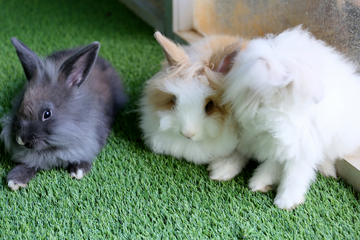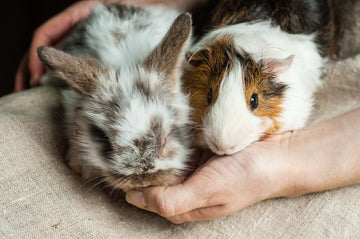Can Rabbits & Cats Coexist?
Many owners of small pets like rabbits also own, or want to adopt, additional animals in their homes. But would getting a pet cat jeopardize the safety of your pet rabbit? It very well may, as felines are predators at heart and rabbits are considered an easy prey. But this is not to say that the two animals — rabbit and cat — can never cohabitate together. It just means that it takes the right approach and patience on the part of the pet owner for it to work.
Click Here to Shop Rabbit Products.

What Can an Owner Do?
Ideally, if you want to own both a cat and a rabbit simultaneously, it is a good idea to acquire both as young animals. But even that does not ensure that your bunny will be safe alone with a natural predator like a cat. For instance, kittens love to play and can often be aggressive. The playful antics of a typical kitten can be perceived as a serious threat to a rabbit. But there are methods to employ that will allow your bunny and cat to coexist peacefully.
Be Patient During the First Introduction
Introducing animals of different species to one another with the goal of their sharing the same living space requires time and patience. You won't get the results you seek overnight; indeed, you could set your poor bunny up for a traumatic and tragic end by rushing the introductory phase. Below are some workable strategies to introduce the potential housemates to one another safely.
Don't Try This With an Indoor-Outdoor Cat
If your cat spends even short periods outdoors, its prey drive will likely be triggered by the introduction to your bunny. This scenario provides no safe outcome for your pet rabbit, so avoid it entirely. However, if you have an indoor cat with a mellow personality and a low predatory drive, cohabitation could work out well.
Phase One: How to Introduce Your Cat and Bunny
Choose a calm day without visitors or other distractions that could upset either pet. Secure your rabbit in a cage with holes too small for even the most intrepid cat paw to invade. Make sure that your bunny has its hidey-hole box inside where it can go to de-stress when necessary. The bunny cage should be big enough for the bunny to both hop and stand up. Your cat needs to be able to observe typical rabbit movements, so they don't trigger the feline prey drive.
Keep the Initial Introduction Short
Set the bunny cage down in the room near the cat. That should be sufficient to pique the cat's curiosity and get them interested in what's inside the cage. Don't be surprised if your bunny hops straight into its hidey hole for the duration of the first exposure to the cat. That's fine. The cat will sniff around the cage and learn what a bunny smells like and your bunny will get its first glimpse of the cat. Fifteen minutes is enough time together for the first encounter. Remember the importance of patience? Depending on the temperament of both bunny and cat, you will need to repeat this step over the course of days, weeks or even months. But gradually, they will both learn to accept the other's presence in the home.
Phase Two: No More Cage
Once both your rabbit and cat have gotten familiar with each other using the cage, it's time to up the ante. With the cat contained loosely on your lap, introduce the bunny into its space. The bunny should be able to approach the cat on its own so it doesn't feel threatened. By now, both should be very familiar with each other's scent and movements. This meeting should be both short and well-supervised. The goal is to keep your small pet happy and healthy during all interactions. But you might be surprised to see that eventually your rabbit assumes the dominant role in the relationship with your cat.
Bossy Bunnies Face Special Risks
When a rabbit gets the upper hand in its relationship with your cat, the cat might take a swipe at it with its paw, claws extended. Your bunny could suffer serious injuries if this occurs, particularly to the eye area. One way to prevent damage to the bunny is to file or clip your cat's claws. Another is to use sheaths to cover the claws. Your goal should always be safety for both animals.
Supervision Is Always Preferable
Even if your cat and rabbit appear to get along like two peas in a pod, it's always better to err on the side of caution. Don't allow the two to interact when you aren't there to supervise and protect your bunny from the instinctive prey drive in your cat.
As you are introducing your rabbit to your cat, remember that they should have constant access to grass hay. Grass hays should be at least 80% of their diet as it has the fiber needed for them to have a healthy digestive system and to help wear down their ever-growing teeth. Did you know you can receive high-quality grass hay for your rabbits, guinea pigs, chinchillas, or other small animals right to your door, just click below to find your small pet's favorite hay.

Fun and Unique Names for Rabbits

Healthy Rabbit Treats for Hoppy Pets





![RHDV2 Critical Information + Frequently Asked Questions [Updated 03/20/2025]](http://www.rabbitholehay.com/cdn/shop/articles/rhdv2-critical-information-frequently-asked-questions-V1.png?v=1742490107&width=360)

